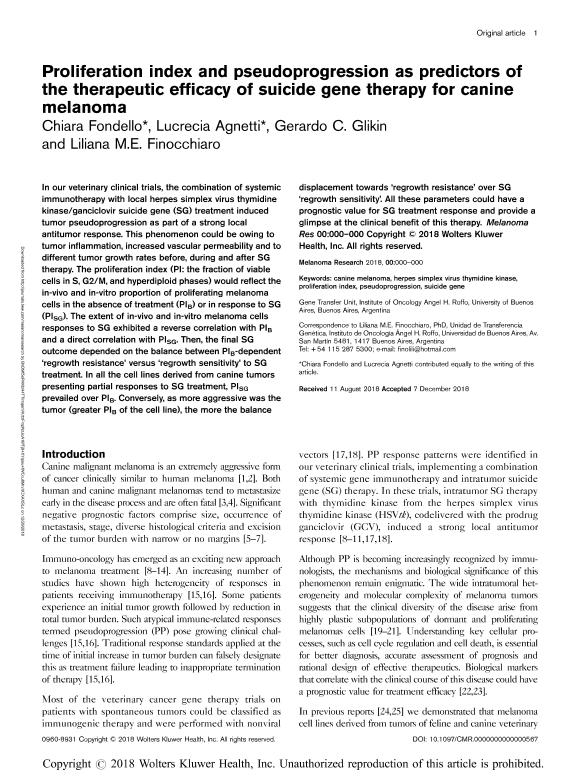Artículo
Proliferation index and pseudoprogression as predictors of the therapeutic efficacy of suicide gene therapy for canine melanoma
Fecha de publicación:
12/2018
Editorial:
Lippincott Williams
Revista:
Melanoma Research
ISSN:
0960-8931
Idioma:
Inglés
Tipo de recurso:
Artículo publicado
Clasificación temática:
Resumen
In our veterinary clinical trials, the combination of systemic immunotherapy with local HSVtk/GCV suicide gene (SG) treatment induced tumor pseudo-progression as part of a strong local anti-tumor response. This phenomenon could be due to tumor inflammation, increased vascular permeability and to different tumor growth rates before, during and after SG therapy. The proliferation index (PI: the fraction of viable cells in S, G2/M and hyperdiploid phases) would reflect the in vivo and in vitro proportion of proliferating melanoma cells in the absence of treatment (PIB) or in response to SG (PISG).The extent of in vivo and in vitro melanoma cells response to SG exhibited a reverse correlation with PIB and a direct correlation with PISG. Then, the final SG outcome depended on the balance between PIB-dependent "re-growth resistance" vs. "re-growth sensitivity" to SG treatment (PIGS). In all the cell lines derived from canine tumors presenting partial responses to SG treatment, PISG prevailed over PIB. Conversely, as more aggressive was the tumor (greater PIB of the cell line) more the balance displacement towards re-growth resistance overcome SG re-growth sensitivity. All these parameters could have prognostic value for SG treatment response and allow us to glimpse the clinical benefit of this therapy.
Archivos asociados
Licencia
Identificadores
Colecciones
Articulos(OCA HOUSSAY)
Articulos de OFICINA DE COORDINACION ADMINISTRATIVA HOUSSAY
Articulos de OFICINA DE COORDINACION ADMINISTRATIVA HOUSSAY
Citación
Fondello, Chiara; Agnetti, Lucrecia; Glikin, Gerardo Claudio; Finocchiaro, Liliana Maria Elena; Proliferation index and pseudoprogression as predictors of the therapeutic efficacy of suicide gene therapy for canine melanoma; Lippincott Williams; Melanoma Research; 30; 2; 12-2018; 1-9
Compartir
Altmétricas




